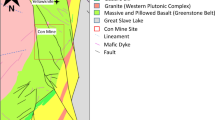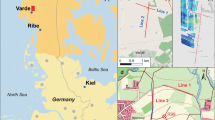Abstract
An innovative mode of groundwater recharge to a buried esker aquifer is considered. The current conceptual model affords a natural safeguard to underlying aquifers from the overlying muds. A hypothesis of groundwater recharge to a buried esker aquifer via preferential pathways across its overlying muds is tested here by heuristic numerical one-dimensional and two-dimensional modeling simulations. The hypothesis has been tested against two other conventionally accepted scenarios involving: (1) distal esker outcrop areas and (2) remote shallow-bedrock recharge areas. The main evidence comes from documented recharge pressure pulses in the overlying mud aquitard and in the underlying esker hydraulic-head time series for the Vars-Winchester esker aquifer in Eastern Ontario, Canada. These perturbations to the potentiometric surface are believed to be the aquifer response to recharge events. The migration rate of these pressure pulses is directly related to the hydraulic diffusivity of the formation. The measured response time and response amplitude between singular radar precipitation events and well hydrographs constituted the heuristic model calibration targets. The main evidence also includes mud-layering deformation (water escape features) which was observed in seismic surveys of the over-esker muds. These disturbed stratigraphic elements provide a realistic mechanism for migrating water to transit through the muds. The effective hydraulic conductivities of these preferential pathways in the muds were estimated to be between 2 × 10−6 and 7 × 10−6 m/s. The implications of these findings relate to the alleged natural safeguard of these overlying muds.
Résumé
Un mode innovant de caractérisation de la recharge d’un esker-aquifère est considérée. Le modèle conceptuel actuel accorde une protection naturelle aux aquifères sous-jacents du fait de la présence des boues les recouvrant. Une hypothèse de recharge des eaux souterraines d’un esker-aquifère par des écoulements préférentiels au travers des boues de couverture est testée ici à l’aide de simulations numériques heuristiques uni-dimensionnelles et bi-dimensionnelles. L’hypothèse a été testée en la confrontant à deux autres scénarios classiquement reconnus impliquant : (1) les zones d’affleurement distal de l’esker et (2) les zones distantes de recharge du soubassement rocheux. La principale preuve provient d’impulsions documentées de pression issues de la recharge dans l’aquitard sus-jacent et dans les séries temporelles de charges hydrauliques de l’aquifère sous-jacent pour l’esker de Vars-Winchester dans l’Est de l’Ontario au Canada. Ces perturbations de la surface potentiomètrique sont considérées comme étant la réponse de l’aquifère aux événements de recharge. La vitesse de migration de ces impulsions de pression est directement reliée à la diffusivité hydraulique de la formation. Le temps de réponse mesuré et l’amplitude de la réponse entre les événements singuliers de précipitations enregistrées par radar et les hydrographes des puits constituent des cibles de calibration du modèle heuristique. La preuve principale comprend également la déformation des lits des boues (produit d’é vacuation de l’eau) qui a été observée dans les études sismiques des boues sus-jacent à l'esker. Ces éléments stratigraphiques perturbés fournissent un mécanisme réaliste pour l’eau migrant au travers des boues. On estime que les conductivités hydrauliques efficaces des écoulements préférentiels dans les boues ont des valeurs comprises entre 2 × 10−6 et 7 × 10−6 m/s. Les implications de ces résultats défie la protection naturelle présumée de ces boues recouvrant les eskers.
Resumen
Se considera un modo innovativo de la recarga de agua subterránea a un acuífero de un esker enterrado. El modelo conceptual actual proporciona una protección natural para los acuíferos subyacentes a los fangos suprayacentes. Aquí se prueba una hipótesis de recarga de aguas subterráneas a un acuífero de un esker enterrado por medio de trayectorias preferenciales a través de los lodos suprayacentes mediante simulaciones heurísticas de modelos numéricos unidimensionales y bidimensionales. La hipótesis se ha probado en relación a otros dos escenarios convencionalmente aceptados que involucran: (1) las zonas distales de afloramiento del esker y (2) las zonas remotas de recarga con roca de base somera. La principal evidencia proviene de los pulsos registrados en la presión de recarga en el acuitardo del fango suprayacente y en las series temporales de la carga hidráulica en el esker subyacente para el acuífero de esker de Vars-Winchester en Ontario del este, Canadá. Se cree que las perturbaciones de la superficie potenciométrica se deben a la respuesta del acuífero a los episodios de recarga. El ritmo de migración de estos pulsos de presión está directamente relacionado con la difusividad hidráulica de la formación. El tiempo de respuesta medido y la amplitud de la respuesta entre los eventos singulares de precipitación de radar y los hidrogramas de pozos constituyeron los blancos heurísticos de calibración de los modelos. La principal evidencia también incluye la deformación de las capas de fango (los aspectos de evacuación de agua) que se observó en las prospecciones sísmicas de los fangos situados por encima del esker. Estos elementos estratigráficos perturbados proporcionan un mecanismo realista para que el agua migrante transite a través de los fangos. Las conductividades hidráulicas eficaces de estas trayectorias preferenciales en los fangos se estimaron entre 2 × 10−6 and 7 × 10−6 m/s. Las implicancias de estos hallazgos se relacionan con la supuesta protección natural de estos fangos suprayacentes.
摘要
考虑到了埋藏蛇形丘含水层地下水补给的创新模式。目前的概念模型从上覆的泥层对下伏的含水层提供了自然的保护。这里依靠启发式的数值一维和二维模型模拟检验了经由穿过上覆泥层的优先通道对埋藏蛇形丘含水层地下水补给的假设。针对两个其他通常所公认的方案对假设进行了检验,这两个方案涉及到:(1)末端的蛇形丘出露区域;(2)偏僻浅层基岩补给区域。主要证据来自文献记载的加拿大安大略省东部Vars-Winchester蛇形丘含水层上覆泥层隔水层补给压力脉冲以及下伏的蛇形丘水头时间序列。这些对静水压面的扰动被认为是含水层对补给事件的反应。这些压力脉冲迁移速度与地层的水力扩散系数直接相关。单一雷达降雨事件和水井水位图之间的测量的响应时间和响应幅度组成了启发式模型校准目标。主要证据也包括泥层变形(跑水特征),这种泥层变形在蛇形丘上面的泥层地震测量中被观测到。这些受到干扰的地层元素为将水穿过泥层进行迁移提供了现实的机理。泥层中这些优先通道的有效水力导水率估计在2 × 10−6 和 7 × 10−6 m/s之间。这些发现意味着和这些上覆泥层所谓的天然保护相关。
Resumo
Considera-se um modo inovador de recarga de água subterrânea de um aquífero instalado num esker soterrado. O modelo conceitual corrente concede às formações silto-argilosas sobrepostas um papel de proteção aos aquíferos subjacentes. Testa-se aqui uma hipótese de recarga a um aquífero num esker enterrado por meio de caminhos preferenciais através de camadas silto-argilosas sobrepostas utilizando simulações com modelagem numérica heurística unidimensional e bidimensional. A hipótese foi testada em contraposição com outros dois cenários convencionalmente aceites envolvendo: (1) áreas distais aflorantes no esker e (2) áreas de recarga situadas em embasamento rochoso remoto e pouco profundo. A principal evidência advém dos impulsos de pressão de recarga documentados no aquitardo superior nas camadas silto-argilosas e nas séries temporais de carga hidráulica no esker subjacente do aquífero do esker Vars-Winchester, em Ontário Oriental, Canadá. Acredita-se que estas perturbações da superfície potenciométrica são a resposta do aquífero a eventos de recarga. A taxa de migração destes impulsos de pressão está diretamente relacionada com a difusividade da formação. As medidas dos tempos e das amplitudes de resposta entre eventos singulares de precipitação obtida por radar e hidrogramas em poços constituem os objetivos de calibração do modelo heurístico. Na evidência principal também está incluída a deformação das camadas silto-argilosas (estruturas de escape de água) observada em levantamentos sísmicos das camadas sobrepostas ao esker. Estes elementos estratigráficos perturbados fornecem um mecanismo determinista realista para a migração da água através das camadas silto-argilosas. As condutividades hidráulicas efetivas destes caminhos preferenciais de percolação nas camadas silto-argilosas foram estimadas entre 2 × 10−6 e 7 × 10−6 m/s. As implicações destes resultados relacionam-se com a alegada proteção natural proporcionada pelas camadas silto-argilosas sobrepostas.












Similar content being viewed by others
References
Anderson MP, Woessner WW (1992) Applied groundwater modeling. Academic, San Diego, CA, 381 pp
Caswell B (1988) Esker aquifers. Water Well J 9 42(7):36–37
Charron JE (1978) Hydrochemical study of groundwater flow in the interstream area between the Ottawa and St. Lawrence rivers. Science Series 76, Ottawa
Cummings D (2006) Core and cutting logs within the Vars-Winchester Esker characterization study, Appendix B. In: Chapman AM, Pugin A, Pullan SE, Hunter JA, Cummings D, Sharpe DR, Russell HAJ (2006) Characterization of the Vars-Winchester esker-aquifer, South Nation River watershed, Eastern Ontario. Summary of field work and other activities, Ontario Geol Surv Open File Rep 6192, 35 pp
Cummings DI, Russell HAJ (eds) (2007) The Vars-Winchester esker aquifer, South Nation River watershed, Ontario: CANQUA Fieldtrip guidebook. Open File 5624, Geological Survey of Canada, Ottawa, 68 pp
Cummings DI, Gorrell G, Guilbault JP, Hunter JA, Logan C, Ponomarenko D, Pugin A, Pullan SE, Russell HAJ, Sharpe DR (2011) Sequence stratigraphy of a glaciated basin fill, with a focus on esker sedimentation. Geol Soc Am Bull 123(7–8):1478–1496
Gadd NR (1988) The late quaternary development of the champlain sea basin. Geological Association of Canada 35:312
Lavoie D, Pinet N, Duchesne M, Bolduc A, Larocque R (2010) Methane-derived authigenic carbonates from active hydrocarbon seeps of the St. Lawrence Estuary, Canada. Mar Pet Geol 27(6):1262–1272
Logan C, Cummings D, Pullan S, Pugin A, Russell HAJ, Sharpe DR (2009) Hydrostratigraphic model of the South Nation watershed region, south-eastern Ontario. Open File 6206, Geological Survey of Canada, Ottawa
McDonald JM, Harbaugh AW (1988) MODFLOW, a modular 3D finite difference ground-water flow model. Techniques of Water Resources Investigations, book 6, chap A1, US Geological Survey, Reston, VA
Morton SR (2012) Evaluating methods for locating and measuring groundwater discharge in steams of the South Nation River watershed, Eastern Ontario. BSc Thesis, University of Ottawa, Canada
Pinet N, Duchesne M, Lavoie D (2010) Linking a linear pockmark train with a buried Paleozoic structure: a case study from the St. Lawrence Estuary. Geo Mar Lett 30(5):517–522
Pugin AJ, Pullan SE (2011) Seismic reflection surveying in regional hydrogeology: an example from the Montérégie region, Quebec. Geohydro 2011:28–31
Pullan S, Pugin A, Hunter J, Burns R, Cartwright T, Douma M, Good R (2006) Geophysical studies Vars Winchester Esker characterization study (2006–07), Appendix A. In: Chapman AM, Pugin A, Pullan SE, Hunter JA, Cummings D, Sharpe DR, Russell HAJ (2006) Characterization of the Vars-Winchester esker-aquifer, South Nation River watershed, Eastern Ontario. Summary of field work and other activities 2006, Ontario Geol Surv Open File Rep 6192, 35 pp
Richard SH (1982) Surficial geology, Russell, Ontario. GSC A series Map 1570A 1:50,000, Geological Survey of Canada, Ottawa
Sauriol J (2015) Pressure pulses as an indication of recharge to a buried esker-aquifer Eastern Ontario. IAH Conference, Waterloo, Canada, October 2015, 10 pp
Sauriol J, Robin MJL (2011) Aquifer discharge fluxes evaluated from spatial variations of stream flow at gaining stream reaches: Vars-Winchester esker aquifer. IAH Conference Geohydro 2011, Québec City, August 2011, 6 pp
Simcore Software (2015) Processing MODFLOW 8.043. http://www.simcore.com/pm8. Accessed September 2014
Sophocleous MA (1991) Stream-floodwave propagation through the Great Bend alluvial aquifer, Kansas: field measurements and numerical simulations. J Hydrol 124(3):207–228
Veillette J, Cloutier V, de Corta H, Gagnon F, Roy M, Douma M, Bois D (2007) A complex recharge network, the Barraute esker, Abitibi, Quebec. In: Proceedings, 8th Joint CGS/IAH-CNC Conference, Ottawa, October 2007
Williams DA, Rae AM, Wolf RR (1985) Paleozoic geology of the Russell-Thurso Area, Southern Ontario. Ontario Geological Survey Map P2717; 1:50,000. Ontario Geol Surv Open File Rep 5770, 291 pp
Acknowledgements
The author wishes to acknowledge the contribution of the following organizations and individuals for their support during the preparation of this research: University of Ottawa (Dr. Michel J. L. Robin), Geological Survey of Canada (Dr. Marc Hinton), South Nation Conservation Authority (Tessa Di Iorio), Kije Sipi Ltd. (Daniel Jobin), and J-F Sabourin & Associates (Jean-François Sabourin). The author wishes to thank Dr. André Pugin for his insights on methane-gas-venting features. The encouragements of Dr. Donald Cummings were truly appreciated during the preparation of this research; his discussions and expressed interest in this controversial subject made a difference in the completion of this report. The discussions with Dr. Simon Gudina and with Mr. Raymond Haché about the surface loading aspect to the hydrographs are acknowledged. The author is grateful to Mrs. Gliceria Briones for the artwork of maps, figures and sketches. The additional contribution of three reviewers and the editor is acknowledged.
Author information
Authors and Affiliations
Corresponding author
Electronic supplementary material
Below is the link to the electronic supplementary material.
ESM 1
(PDF 1266 kb)
Rights and permissions
About this article
Cite this article
Sauriol, J. Provenance of buried esker groundwater: the case of Vars-Winchester esker aquifer, Eastern Ontario, Canada. Hydrogeol J 24, 123–139 (2016). https://doi.org/10.1007/s10040-015-1327-1
Received:
Accepted:
Published:
Issue Date:
DOI: https://doi.org/10.1007/s10040-015-1327-1




